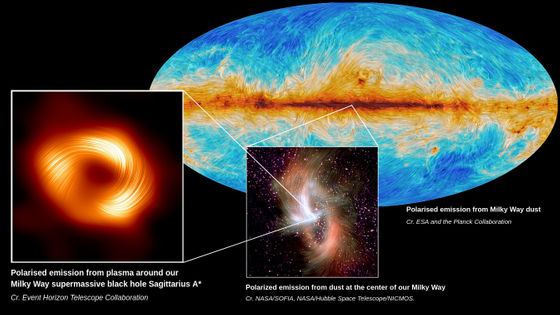New image of supermassive black hole Sagittarius A* reveals intense swirling magnetic field for the first time

The Event Horizon Telescope (EHT), which released an image of the massive black hole
First Sagittarius A* Event Horizon Telescope Results. VII. Polarization of the Ring - IOPscience
https://iopscience.iop.org/article/10.3847/2041-8213/ad2df0
First Sagittarius A* Event Horizon Telescope Results. VIII. Physical Interpretation of the Polarized Ring - IOPscience
https://iopscience.iop.org/article/10.3847/2041-8213/ad2df1
A powerful magnetic field swirling around the edge of the black hole at the center of the Milky Way has been discovered | EHT-Japan
https://www.miz.nao.ac.jp/eht-j/c/pr/pr20240327.1.html
Below is a newly released image of Sagittarius A* by the EHT. The lines indicate the direction of ' polarized light ,' and the image captures the magnetic field around the 'black hole shadow,' which is the shadow cast by the black hole.
Breaking news: the Event Horizon Telescope team unveils strong magnetic fields spiraling at the edge of Milky Way's central black hole, Sagittarius A*. This new image suggests that strong magnetic fields may be common to all black holes.
— Event Horizon 'Scope (@ehtelescope) March 27, 2024
#OurBlackHole #SgrABlackHole pic.twitter.com/BV8eON4Jhc
According to EHT, this is the first time that polarized light, which indicates a black hole's magnetic field, has been captured so close to the edge of Sagittarius A*.
'What we're seeing right now is a powerful magnetic field aligned in a spiral pattern near the black hole at the center of the Milky Way,' said Sarah Issaun, an astrophysicist at the Harvard-Smithsonian Center for Astrophysics.

The light that humans need to see things is a vibrating, or moving, electromagnetic wave. At this time, light can vibrate in a specific direction, and this is what the previously mentioned 'polarized light' refers to.
In the plasma surrounding a black hole, particles swirling around the magnetic field lines impart a polarization pattern perpendicular to the field lines, and this effect was exploited to create the image above.
So what does our spiral pattern tell us about the magnetic fields around Sagittarius A*? The field is actually strong and ordered!
#MagneticBlackHole #EHTblackhole
cr. Crazybridge Studios, EHT Collaboration
???? https://t.co/lAWZ5Jiukr pic.twitter.com/Pgd9QCUzDm — Event Horizon 'Scope (@ehtelescope) March 27, 2024
In 2022, the EHT will release the first images of Sagittarius A*, located about 27,000 light-years from Earth, revealing a striking similarity between theblack hole in Sagittarius A* and the black hole in M87 , which was first imaged in 2019, despite it having only about one-thousandth of the mass of the black hole in M87.
First image of a black hole in the same galaxy as Earth captured - GIGAZINE

Given the similarities between the two black holes, despite their different masses and the galaxies they belong to, the ETH researchers suspected they had more in common than just their appearances, and so they carried out a polarized light analysis. In two papers published in The Astrophysical Journal Letters, they revealed the existence of similar magnetic field structures at the edges of these black holes.

'We discovered that the magnetic field structure of Sagittarius A* is very similar to that of M87,' said Professor Maria Felizia De Laurentiis of the University of Naples Federico II in Italy. 'This is an important discovery because it suggests that the physical process by which gas is supplied to black holes and some of it is ejected as jets may be universal among massive black holes, despite differences in mass, size and surrounding environment.'
The EHT has conducted multiple observations since 2017, and is scheduled to observe Sagittarius A* again in April 2024. In addition, updates planned for the next 10 years are expected to produce reliable videos of Sagittarius A*, which will enable researchers to identify the existence of a so-far unidentified ' jet .'
Related Posts:






